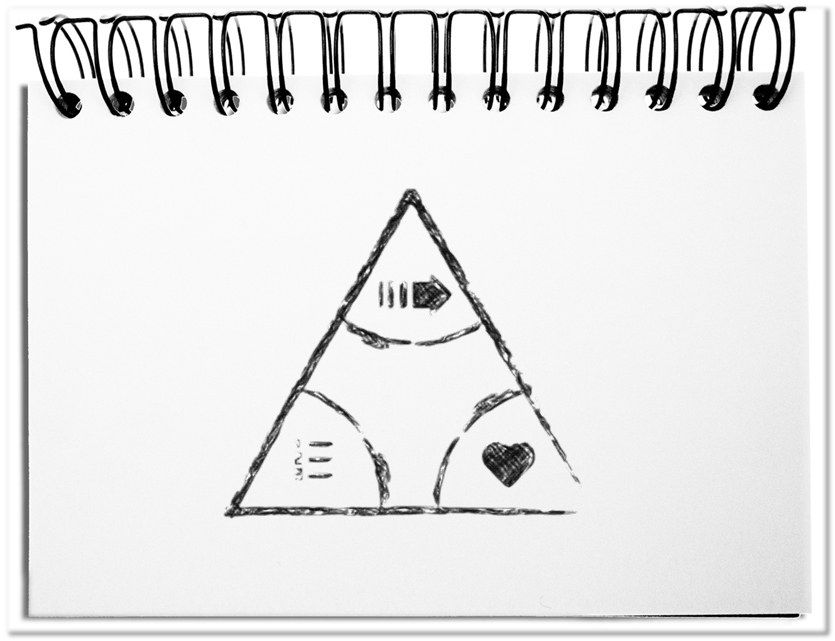Durchgängige Vernetzung und vielfältige Kanäle bieten nicht nur den üblichen Medienanbietern eine Plattform zur Veröffentlichung, sondern allen, die sich berufen fühlen. Die einzige Voraussetzung ist der Zugang zum Internet. Aus diesem Grund steht uns eine unübersehbare Flut von Informationen zur Verfügung – egal woher, von wem, von wann, ob richtig oder falsch. Dadurch entstehen neue Möglichkeiten zur Nutzung, Betriebsmodelle und Interessen, um die Zielgruppen zu informieren. Und alle suchen ihren Platz im Publikationsdreieck.
Der ideale Platz befindet sich in der Mitte des Dreiecks – gleichzeitig sachlich, emotional und wirksam. In Deutschland beanspruchen die ausgewogenen Positionen die öffentlich-rechtlichen Medien. Schauen wir uns das Dreieck mal näher an.
- Die sachliche Ecke
Nehmen wir mal an, es gäbe so etwas wie eindeutige Nachrichten, die etwas so beschreiben, wie es ist – ganz ohne Weglassen von Inhalten, Verallgemeinerungen und Verzerrungen. Die Bestandteile wären unbelastet von bewussten oder unbewussten Absichten. Alle würden das Gleiche darunter verstehen.
Am besten lassen sich Ereignisse und physische Dinge sachlich beschreiben – es ist jetzt 17:32 Uhr; heute ist Freitag; es regnet; ich tippe auf einer schwarzen Tastatur; ich nutze MS-Word. Nehmen wir das folgende Beispiel: Vor dem Café, in dem ich sitze, haben sich Gruppen von Jugendlichen zusammengerottet, skandieren ihre Parolen und bewegen sich in Richtung Rathaus, wo bereits Polizeieinheiten ihre Stellung beziehen … Mit dieser Beschreibung hat man sich bereits aus der sachlichen Ecke herausbewegt. Vor allem, wenn man bedenkt, dass ich unterschlagen habe, dass sich neben dem Rathaus das Fußballstadion befindet, in dem später ein Spiel stattfindet.
Die Wortwahl liefert nicht nur sachliche Inhalte, sondern zusätzliche Informationen z. B. über den Kontext, die Absichten und Bewertungen. Und am Ende entscheidet die Zielgruppe über den Gehalt der Nachricht. Für erklärte Gegner von Fußball wird es keinen Unterschied machen, ob es sich um Fußballfans oder demonstrierende Extremisten handelt.
Ich fürchte, man muss damit leben, dass die sachliche Ecke unerreichbar ist – egal, wie viel Sachlichkeit Berichterstatter für sich in Anspruch nehmen erzeugen die Unvollständigkeit der Inhalte und das Assoziationspotenzial der Empfänger unterschiedliche Bedeutungen im Kopf der Einzelnen. - Die emotionale Ecke
Von fiktiven Geschichten erwarten die meisten nichts weiter als Stimmigkeit. Solange die einzelnen Elemente zueinander passen, werden sie aufgenommen und verarbeitet, ohne dass etwas tatsächlich wahr ist. In dieser Ecke werden negative Emotionen (z. B. sich ohnmächtig anderen ausgeliefert oder sich ausgeschlossen und erniedrigt zu fühlen) und positive (z. B. das Gefühl selbst entscheiden und bestimmen zu können oder anerkannt zu sein) angesprochen.
Spürbar werden die Effekte, wenn Beschreibungen beim Empfänger auf emotional aufgeladene Erfahrungen treffen – die Abschlussprüfung; der Tsunami; die Passion; die Madeleine. Die mentale Verbindung mit dem Erlebnis, erweckt die damaligen Gefühle – Freude, Überraschung, Angst, Ärger, Traurigkeit, Scham … Je nach Naturell wird man völlig in diese Ecke hineingezogen. Besonders augenfällig wird das im Kino, wenn die Sitznachbarn schallend loslachen oder in Tränen ausbrechen.
Die emotionale Ecke lässt sich durch geschickt gewählte Situationen und die Wortwahl verstärken – der einsame weiße Sandstrand an einem türkisfarbenen Meer mit einer orangefarbenen Sonne, die langsam am Horizont verschwindet; haushohe metallene Wellen, die durch New Yorker Straßenschluchten branden; das feine Schleifpapier, das den Klangkörper einer Geige streichelt; der Duft und der Geschmack einer Madeleine, die Marcel Proust in seine Kindheit beamen.
Dieser Ecke entkommt man nicht, da die Gefühle ungewollt im Unterbewusstsein ausgelöst werden, wenn eine entsprechende Erfahrung gespeichert ist. Manche Gefühle werden durch jahrelangen Medienkonsum verinnerlicht und von Anbietern ausgenutzt, um unsere Aufmerksamkeit zu erheischen. In einem derartigen trojanischen Pferd verstecken sich weitere Absichten, die automatisch zusätzliche Bedarfe auslösen – der Wunsch bestimmte Produkte und Dienstleistungen zu konsumieren; das Bedürfnis nach Sicherheit; der unbewusste Drang, Teil einer Mehrheitsposition zu sein usw. - Die wirksame Ecke
Die Absender verfolgen mehr oder weniger bewusst einen Zweck mit ihren Veröffentlichungen – einer Mitteilung soll geglaubt werden; ein Versprechen soll eingehalten werden; ein Lob soll erfreuen; eine Benennung soll akzeptiert werden; eine Aufforderung soll auch zu einer Umsetzung führen.
Das Betriebsmodell bestimmt die Wirkung, die wirtschaftlicher (Geschäftsmodell), politischer (das politische Agenda) oder religiöser Natur (die Konfession) sein kann. Eine Zeitung ist erfolgreich, wenn sie viel gekauft und gelesen wird. Eine Partei hat die gewünschte Wirkung erzielt, wenn sie von der Mehrheit gewählt wird. Eine Kirche ist gut besucht, wenn die Schar der Gläubigen wächst.
Die Erwartungen des Publikums entscheiden in dieser Ecke über den Erfolg. Er wird bestimmt durch den erforderlichen Mix von Sachlichkeit und Emotionalität. Diese Ecke hat einen großen Einfluss auf die Position im Dreieck. So kann eine sachliche Berichterstattung eines Nachrichtenkanals zu einer Propagandamaschine werden, wenn die Ängste des Publikums populistisch geschürt werden – denken wir an die Medieneinsätze von Trump und Berlusconi. Die Auswahl der Themen wird getrieben von den wirtschaftlichen Interessen einer Zeitung oder eines Senders – zielgruppenorientierte Inhalte erhöhen die Auflage. Der Blogger, der auf der Jagd nach Likes seinen Kanal mit immer neuen Inhalten versorgt, achtet dabei nicht nur auf sein Publikum, sondern auch auf die Interessen seiner Geldgeber.
In dieser Ecke versteckt sich die tatsächliche Absicht eines Anbieters. Der Spruch von Cicero „Cui bono?“ (d.h. wem nutzt es?) offenbart die wirklichen Absichten. Der erste Blick in das Publikationsdreieck sollte in dieser Ecke beginnen, da sich hier die Begründungen für die beiden anderen Ausrichtungen finden.
Fazit: Wir sollten heute nicht mehr von einer Informationsflut sprechen, sondern von einem durchgängig höheren Informationsstand, dem wir ausgesetzt sind. Und alle diese Inhalte lassen sich im Publikationsdreieck verorten. Wir bemerken bewusst oder unbewusst einen sachlichen Inhalt, die emotionale Färbung und die beabsichtigte Wirkung. Durch die Erreichbarkeit von fast allen Menschen müssen wir uns bewusst sein, dass wir keinen natürlichen Mechanismus ausgeprägt haben, der uns vor der manipulativen Wirkung der Medien schützt. Aus diesem Grund sollten wir uns beim Faktencheck mehr auf das Publikationsdreieck fokussieren – was bedeutet die Nachricht für mich? Warum spricht sie mich an? Wem nützt sie? Es bleibt abzuwarten, ob wir in absehbarer Zeit einen Weg aus dem Spannungsfeld informiert vs. beeinflusst zu werden finden.

